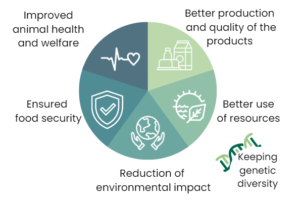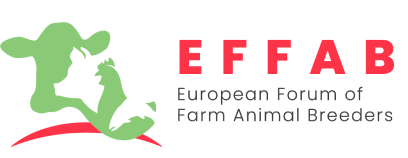What can animal genetics do to reduce emissions from livestock?
Author: Oscar González-Recio.
Affiliation: Senior Research Scientist at Dpt Animal Breeding, INIA-CSIC. Ctra. La Coruña km 7.5 28040 Madrid (Spain)
During the last years the scientific community of FABRE TP has been investigating how to reduce methane emissions from ruminants through animal breeding. There are two sources of genetic information that can be utilized in breeding programs
1) the animal genome (the genetic information) and
2) the genome of the microorganisms in the rumen (also known as the metagenome).
Methane is produced by some of the microorganisms in the rumen during feed digestion. According to our results, animals with a reduced number of certain protozoa and archaea in the rumen showed a lower methane emission level, because they also host a lower abundance of methanogens, which are more difficult to detect.
The study of the composition and functions of this complex community of microorganisms and its relationship with the genome of the animal (the cow) represent a huge amount of new knowledge. Animal breeding and, in particular genomic selection can focus on detecting those genes that modulate the rumen population of microorganisms (microbiome) to reduce the number of methanogenic microorganisms (those producing methane).
Saborío-Montero et al. (2021,2022) showed that the relative abundance of rumen microorganisms is controlled by some genes, with heritabilities between 10-40%, and that they are genetically correlated with enteric methane. This is the contribution of genetics to the differences between animals for the relative abundance of these microorganisms in the rumen: animals within the same family have more similar microbiota composition than between families, and genomic variants in the cow genome explain part of these differences between them (differences on their phenotype, what they look like). Some of these genes (or close-by genes) are influencing methane production. This means that selecting animals that favor the growth of certain combinations of microbes will also reduce enteric methane production in the next generations. Some of these microbes are also associated to an improved feed efficiency and production traits, promoting a more efficient digestion of feed and its transformation to milk.
Genetic selection towards lower emissions
In order to include methane in animal breeding schemes, it is necessary to register individual methane measurements (Figure 2) at least in a large enough proportion of the population (called reference population). Then, genomic selection can be applied using phenotypes and genotypes in the population. Continuous or periodical methane recording in part of the population facilitates calculating genetic and phenotypic progress. Then, it needs to be included in the breeding programs, as a new goal.

Figure 3. Methane concentration measured with a non-dispersive infrared detector from eructation events in Holstein cattle.
González-Recio et al. (2020) showed that reduction through breeding of total methane production and methane intensity per unit of product is possible mainly due to selection for higher production, better longevity and feed efficiency, needing fewer cows to produce the same amount of milk.
However, a large reduction (>20%) in 10 years is only possible if a large weight in the selection indices is applied on methane traits. And as usual, when new breeding goals and traits are included in breeding programs, the balance between them needs to be adapted. This is what modern animal breeding is, a responsible combination of different goals (Figure 3).

Figure 4. The 6 pillars of balanced and responsible breeding in line with EFFAB’s Code EFABAR
Conclusions
Animal-sourced products are part of a healthy diet. Livestock contributes to rural vitality, and development and maintains the environment. Strategies to reduce methane emissions from livestock must be considered carefully, and they may be case-specific, taking into account all possible consequences, including those as a result from reducing the number of animals. Ruminants play an important role in resilient food systems, by recycling non-edible material and by-products.
Animal breeding is an efficient tool to mitigate methane emissions and is readily available. However, efforts are needed to measure methane at a large scale. Once it is included in the breeding programs, considering the particularities of each population, it is important to evaluate and monitor changes in the rumen microbiota to keep a healthy and efficient pseudo-organ.
References
- González-Recio O., López-Paredes, J., Ouatahar L., Charfeddine N., Ugarte E., Alenda R and Jiménez-Montero J.A. 2020. Mitigation of greenhouse gases in dairy cattle via genetic selection (ii): incorporating methane emissions into the breeding goal. Journal of Dairy Science 103:7210–7221. https://doi.org/10.3168/jds.2019-17598.
- Saborío-Montero, A., Gutiérrez-Rivas, M., Goiri, I., Atxaerandio R.,García-Rodriguez, A., López-Paredes, J., Jiménez-Montero, J.A., Gonzalez-Recio, O. 2022. Rumen eukaryotes are the main phenotypic risk factors for larger methane emissions in dairy cattle. Livestock Science, 263: 105023. ISSN 1871-1413. https://doi.org/10.1016/j.livsci.2022.105023.
- Saborío‐Montero A, Gutiérrez‐Rivas M, López-García A., Atxaerandio R., Goiri I, García‐Rodríguez A, Jiménez-Montero J.A., González C., Tamames J., Puente-Sánchez F., Varona L., Serrano M., Óvilo C., González-Recio, O. 2021. A dimensional reduction approach to modulate the core ruminal microbiome associated with methane emissions via selective breeding. J. Dairy Sci, 104(7):8135-8151. https://doi.org/10.3168/jds.2020-20005.
